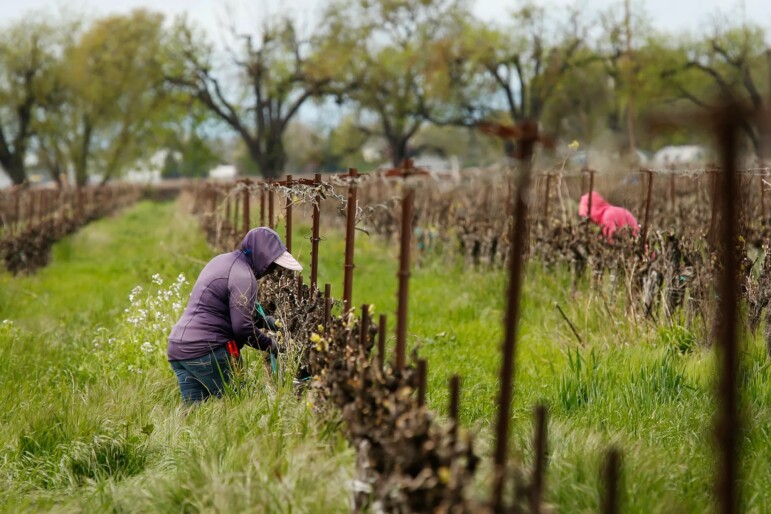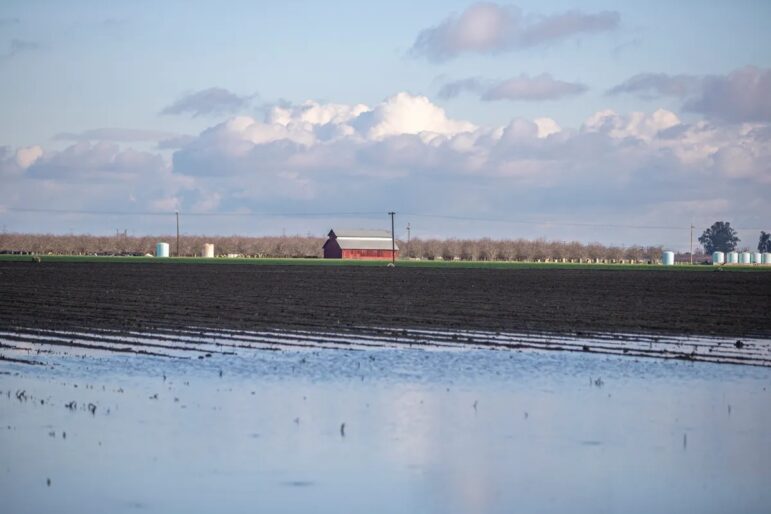Lea este artículo en español.
Torrential rains and floods submerged whole towns and killed more than 20 people in parts of California in January. They also caused thousands of farmworkers to lose weeks of pay because the flooded fields and orchards were surrounded by treacherous, watery and muddy roads.
The steep storm-related losses — along with recent revelations that some farmworkers are living in substandard conditions — are bolstering advocates’ argument that California should expand its safety net to help its agricultural workforce survive such setbacks.
Some lawmakers are listening to them.
State Sen. María Elena Durazo and Assemblymembers Wendy Carrillo and Miguel Santiago — all Democrats from Los Angeles — introduced SB 227, which would create an Excluded Workers Program to pay undocumented, unemployed workers $300 per week for each week of unemployment, up to 20 weeks.
The state-funded program would be a boon for many farmworkers, supporters said.
“We had wildfires, now we have floods,” said Santiago. “There are really good reasons why hardworking people can’t get to work. And there’s no safety net.”
Last year it was the COVID pandemic affecting the farm workforce and many other industries. The Legislature passed a similar unemployed workers bill, referring to the pandemic, with mostly Democratic support.
But Newsom vetoed it, saying at the time that just equipping and launching the program would cost more than $200 million in upfront general funds, not counting the actual cost of the unemployment benefits.
The proposal last year had an estimated benefits cost of $597 million. So far there has been no similar estimate included with the new bill’s language.
In addition to unemployment payments, which are the top idea among several lawmakers and advocates, other options under discussion to help farmworkers include disaster or hazard pay and drought relief funds.
Lost income
Some farmworkers rely on work in January to supplement their income in other seasons, whether harvesting strawberry fields in the Central Coast or pruning fruit trees in San Joaquin Valley orchards. Regardless of their immigration status, many of those families already on the poverty line fell into more financial peril after the floods.

Salvador Negrete, who usually works in orange groves and pistachio orchards in Madera County this time of year, lost 14 work days when storms flooded the orchards. He figures he lost about $1,100 in income in January.
“Many farmworkers aren’t here legally and they don’t get government support,” he said in Spanish. “Many of us workers have families. We worry (because) we have very little. We can’t afford our bills and everything is expensive.”
Some others were worse off. Cecilia Rodriguez, a farmworker and mother of two small children, said she lost several days of tying and pruning work in Healdsburg vineyards in January, amounting to about $3,000 in lost income.
“I think that this has hurt everyone financially, more than anything, because everything is very expensive these days, like food, rent — it’s too expensive,” she said.
Rodriguez also is an organizer with North Bay Jobs With Justice, a coalition of labor and community organizations in Sonoma, Napa and Marin counties.
Generally non-citizens who don’t have authorization to work in the United States don’t qualify for unemployment benefits in California. In 2021 nearly 15% of California’s workers were non-citizens and 6% were undocumented, according to a University of California Merced study
About six in 10 farmworkers are undocumented, a large chunk of the state’s more than 1 million workers not qualifying for unemployment insurance. They also aren’t eligible for many other state and federal safety net programs. And recently Gov. Gavin Newsom floated a budget proposal that delays rolling out food assistance benefits to immigrant workers.
Crises to come
Advocates warn that January won’t be the last time California’s agricultural workforce endures tumultuous weather or the natural effects of climate change.
“2023 is on course to be the hottest year on record in the history of the planet, so we’re probably going to have some of the worst wildfires we’ve ever seen,” predicted Max Bell Alper, executive director of North Bay Jobs with Justice. “Farmworkers are going to be in a very difficult situation. This is just the start of the year.”
Earlier this year Newsom did not include money for an unemployed undocumented worker fund in his latest budget proposal. In general he has proposed delaying or reducing some previously committed expenditures to help plug a $22.5 billion budget hole, which some projections warn may be larger by May.
Santiago objected, saying in an interview that if the state could prioritize a middle class refund, it could prioritize helping immigrants, despite a budget shortfall.
“We’re not talking about people who haven’t contributed, who haven’t paid taxes, but (people) who are part of California’s engine of success,” he said. “We’re talking about extremely hardworking people who make extremely low wages.”
Statewide proposals
A few states, including California, provided some temporary relief for undocumented workers harmed by COVID. Colorado last year became the first to create a long-term fund to provide unemployment benefits to workers regardless of immigration status.
It’s time California made a similar long-term investment, said Sarait Martinez, executive director of the Binational Center for the Development of Oaxacan Indigenous Communities, a nonprofit in the Central Valley.
“Other states are doing it,” she said. “I don’t see why, being one of the top economies, we cannot provide for workers to be OK during times of crisis or to have a safety net for them to rely on when there’s no job or when disaster happens.”
Beside the unemployment proposal, some advocates discussed other options to help workers.

North Bay Jobs for Justice has called for disaster pay for California farmworkers. Alper said employers should have to pay workers not only for the rain and flooding they encountered in January, but also for the smoke, fire and heat risk they might work under throughout the year.
Union officials said some workers can get hazard pay written into labor union contracts. The farmworkers at E&J Gallo secured disaster pay — in this case, extra money for working in poor air from wildfires — in their most recent contract with the winery in Sonoma County, Alper said.
Most farmworkers are not represented by a union; union membership in California is less than 1%. Some farmers, like the Sonoma County winery Eco Terreno, offer hazard pay to employees even though workers aren’t unionized.
Disaster resources
There’s also a renewed legislative attempt to provide three years of monthly cash aid to farmworkers who lost work to California’s ongoing drought. State senators Melissa Hurtado, a Democrat from Sanger, and Tom Umberg, a Garden Grove Democrat, on Jan. 30 introduced SB 262, which would create the California Farmworkers Drought Resilience Pilot Project.
Newsom vetoed a similar bill Hurtado authored last year, saying the $20 million program would cost far more to operate.
Irene de Barraicua, director of operations for the statewide advocacy group Lideres Campesinas, suggested another option: Farmers usually purchase crop insurance to guard against losses from natural disasters; why can’t something similar be available for farmworkers?
“After all, it’s a $50 billion industry here,” she said. “The main thing is being able to compensate people for their lost wages during natural disasters.”
Some advocates point to a recent effort in Sonoma County as a model for the state to quickly meet the needs of farmworkers in trouble.
County officials used county funds in mid-January to open two resource centers, in Guerneville and Healdsburg, to help people who lost work because of the storms. Working with local nonprofits, labor and faith-based organizations, the centers helped 1,110 people initially with emergency financial aid and groceries to replace food lost to flooding or spoiling during power outages.
The centers also helped connect people with county and federal disaster resources. People who couldn’t safely reach the centers found help by calling a county hotline.
By early February, Sonoma County’s supervisors had increased its funding to $1 million, after disbursing $300,000.
One of its grant partners, the Sonoma County Community Organizations Active in Disasters (COAD), grew from a collaboration created after the 2017 Tubbs Fire, which burned 36,807 acres and killed 22 people, putting many farmworkers out of work.
After the Tubbs Fire, some grower groups dispensed aid to workers.
This time farmworkers are telling intake people that their employers are sending out-of-work employees to the resource centers, said Jeanette Pantoja, director of the disaster group.
Some of today’s flooded out farmworkers are still recovering from wildfires, she said. During a shift at the Healdsburg center, Pantoja met a man impacted by the flooding who also asked for help replacing a personal ID he lost in a wildfire in 2020.
“There’s a sense that they’re just going into a deeper and deeper crisis with each one of these events,” Pantoja said.
